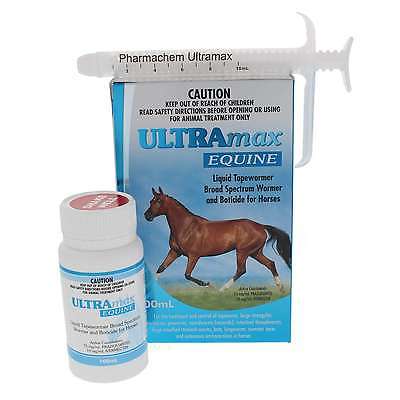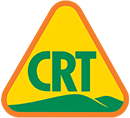Pharmachem Ultramax Equine 100mL
Pharmachem Ultramax Equine 100mL
Active Constituents:
175 mg/mL PRAZIQUANTEL
10 mg/mL IVERMECTIN
Mode of Action
Ivermectin is a member of the macrocyclic lactone class of endectocides which have a unique mode of action. Compounds of the class bind selectively and with high affnity to glutamate- gated chloride ion channels which occur in invertebrate nerve and muscle cells. This leads to an increase in the permeability of the cell membranes to chloride ions with hyperpolarization of the nerve or muscle cell, resulting in paralysis and death of the parasite. Compounds of this class may also interact with other ligand-gated chloride channels, such as those gated by the neurotransmitter gamma-aminobutyric acid (GABA).The margin of safety for compounds of this class is attributable to the fact that mammals do not have glutamate-gated chloride channels; the macrocylic lactones have a low affinity for other mammalian ligand-gated chloride channels and they do not readily cross the blood-brain barrier. Praziquantel induces a rapid and sustained paralytic muscle contraction of the tapeworm parasite and tegmental disruption followed by expulsion of the parasite.
Indications:
Ultramax Equine when used at the recommended dose rate of 200µg ivermectin per kilogram liveweight and 1.5 mg/kg praziquantel controls the following parasites of horses:
- Tapeworms: Anoplocephala perfoliata, Anoplocephala magna, Paranoplacephala mamillana (adult, immature, heads, segments).
- Large Strongyles: Strongylus vulgaris (adults and arterial larval stages), Strongylus edentatus (both adult and tissue stages), Strongylus equinus (Adults), Tridontophorus spp. (Adults), Craterostomum acuticaudatum (Adults)
- Small Strongyles: including benzimidazole resistant strains Cyathostomum spp. (Adults and fourth-stage larvae), Cylicocyclus spp. (Adults and fourth-stage larvae), Cylicostephanus spp. (Adults and fourth-stage larvae), Cylicodontophorus spp. (Adults and fourth-stage larvae), Gyalocephalus spp. (Adults and fourth-stage larvae), Coronocyclus spp. (Adults and fourth-stage larvae), Parapoteriostomum spp. (Adults and fourth-stage larvae), Petrovinema spp. (Adults and fourth-stage larvae), Poteriostomum spp. (Adults and fourth-stage larvae)
- Pinworms: Oxyuris equi (Adults and fourth-stage larvae)
- Ascarids: Parascaris equorum (Adults and fourth-stage larvae)
- Bots: Gasterophilus spp. (oral and gastric stages)
- Hairworms: Trichostrongylus axei (Adult)
- Intestinal Threadworms: Strongyloides westeri (adult)
- Large Mouth Stomach Worms: Habronema muscae (adult)
- Lungworms: Dictyocaulus arnfedi (adult and immature)
- Ultramax Equine also controls skin lesions caused by cutaneous larvae of Habronema and Draschia spp. (summer sores), and Onchocerca spp., microflaraiae (cutaneous onchocerciasis)
Directions for Use:
The recommended dose is 1mL Ultramax Equine per 50kg liveweight (equivalent to 200µg ivermectin per kg liveweight and 1.5 mg praziquantel per kg liveweight).
Ultramax Equine can be given as an oral drench or by stomach tube (nasogastric intubation). Nasogastric intubation should only be done by a veterinarian or under veterinary supervision.
Discard any unused diluted Ultramax Equine suspension 24 hours after dilution.
Develop a Regular Treatment Plan:
All horses should be subject to regular worming to maintain good health and peak condition. Particular attention should be given to young horses and mares. Foals should be treated initially at 6 to 8 weeks of age and this treatment repeated regularly as required. Frequency of treatment should be assessed by each property’s veterinary adviser considering the number of horses, their age distribution, reproductive status, stocking rate, grazing access, climate and property’s parasite infestation status.
Safety:
Ultramax Equine may be used both in young foals and very old animals. Mares may be treated at any stage of pregnancy and fertility will not be affected in either sex. Swelling and itching reactions after treatment with Ultramax Equine have occurred in horses carrying heavy infections of neck threadworm microflariae, Onchocerca sp. These reactions were most likely the result of microflariae dying in large numbers. Symptomatic treatment may be advisable.
Healing of summer sores involving extensive tissue changes may require other therapy in conjunction with Ultramax Equine. Reinfection, and measures for its prevention should also be considered.
DO NOT USE IN ANIMALS OTHER THAN HORSES
MEAT WITHHOLDING PERIOD: Do not use less than 28 days before slaughter for human consumption.


